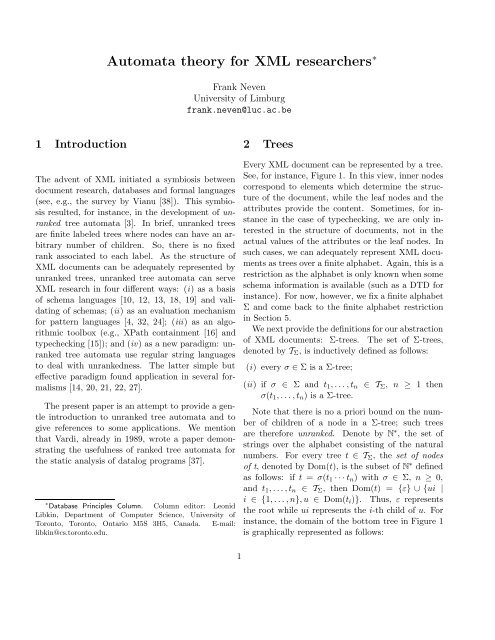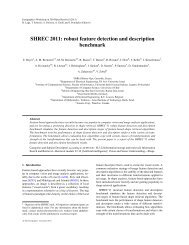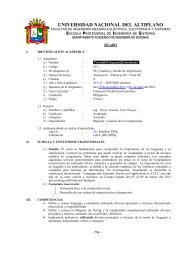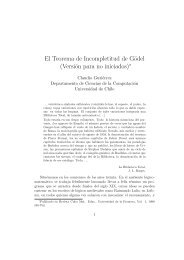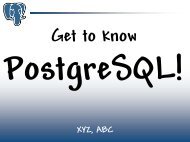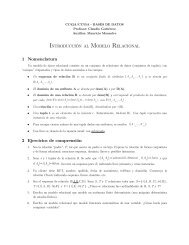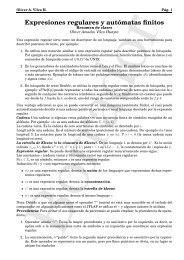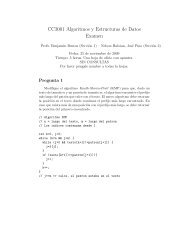Automata theory for XML researchers - Department of Computer ...
Automata theory for XML researchers - Department of Computer ...
Automata theory for XML researchers - Department of Computer ...
You also want an ePaper? Increase the reach of your titles
YUMPU automatically turns print PDFs into web optimized ePapers that Google loves.
Kermit Frog Ms. Piggy creatorHensonmuppetmuppetname animalKermit FrogfriendsnameMs. Piggycreator name animal friendsnameFigure 1: A sample <strong>XML</strong> document, its tree representation, and its structural representation.Example 3.2. Consider the alphabet Σ ={∧, ∨, 0, 1}. Suppose <strong>for</strong> ease <strong>of</strong> exposition thattrees are always as follows: 0 and 1 only appear atleaves, and ∧ and ∨ can appear everywhere exceptat leaves. These are all tree-shaped boolean circuits.We next define an automaton accepting exactly thecircuits evaluating to 1. Define A =(Q, Σ,δ,F) withQ = {0, 1}, I 0 = {0}, I 1 = {1},F = {1}, andδ(0, 0, ∧) =0 δ(0, 1, ∧) =0;δ(1, 0, ∧) =0 δ(1, 1, ∧) =1;δ(0, 0, ∨) =0 δ(0, 1, ∨) =1;δ(1, 0, ∨) =1 δ(1, 1, ∨) =1.Intuitively, A works as follows: A assigns 0 (1) to0-labeled (1-labeled) leaves; further, A assigns a 1 toa ∧-labeled node iff both its children are 1; and, Aassigns a 0 to a ∨-labeled node iff both its childrenare 0. Finally, A accepts when the root is labeledwith 1. So, in this example, the bottom-up viewis the most intuitive one. In Figure 2, we give anexample <strong>of</strong> an accepting run on a tree.In Example 3.4, we give an automaton evaluatingan XPath expression <strong>for</strong> which the top-down view ismore natural.✷3.3 <strong>Automata</strong> on unranked treesExtending the tree automata <strong>of</strong> the previous sectionto unranked trees implies that we should definethe transition functions <strong>for</strong> any number <strong>of</strong> children:δ : ⋃ ∞n=0 Qn × Σ → 2 Q . To achieve the latter,∨0 1∧∧1 110 1111 1Figure 2: A tree and an accepting run <strong>of</strong> the automaton<strong>of</strong> Example 3.2.Brüggemann-Klein, Murata, and Wood [3], based onthe work <strong>of</strong> Pair and Quere [30] and Takahashi [36],use regular string languages over Q to represent transitions.That is, the transition function δ is a mappingδ : Q × Σ → 2 Q∗ such that δ(q, a) is a regularstring language over Q.Definition 3.3. A nondeterministic tree automaton(NTA) is a tuple B =(Q, Σ,δ,F), where Q is a finiteset <strong>of</strong> states, F ⊆ Q is the set <strong>of</strong> final states, and δ isa function Q×Σ → 2 Q∗ such that δ(q, a) is a regularstring language over Q ∗ <strong>for</strong> every a ∈ Σ and q ∈ Q.A run <strong>of</strong> B on a tree t is a labeling λ : Dom(t) → Qsuch that <strong>for</strong> every v ∈ Dom(t) with n children,λ(v1) ···λ(vn) ∈ δ(λ(v), lab t (v)).Note that when v has no children, then the criterionreduces to ε ∈ δ(λ(v), lab t (v)). So, we do not needan explicit definition <strong>of</strong> the I σ ’s anymore. A run isaccepting iff the root is labeled with a final state,that is, λ(ε) ∈ F . A tree is accepted if there is anaccepting run <strong>for</strong> it. The set <strong>of</strong> all accepted trees isdenoted by L(B).3
We illustrate the above definition with two examples.In the first example we represent the transitionfunctions by regular expressions. In the second examplewe use logical <strong>for</strong>mulas.Example 3.4. (1) We continue Example 3.2. Innernodes can now have an arbitrary number <strong>of</strong> children.Again, we define an automaton accepting exactly thecircuits evaluating to 1. Define B =(Q, Σ,δ,F) withQ = {0, 1}, F = {1}, andδ(0, 0) := δ(1, 1) := {ε};δ(0, 1) := δ(1, 0) := ∅;δ(0, ∧) := (0+1) ∗ 0(0 + 1) ∗ ;δ(1, ∧) := 1 ∗ ;δ(0, ∨) := 0 ∗ ;δ(1, ∨) := (0+1) ∗ 1(0 + 1) ∗ .Intuitively, B works as follows: B assigns 0 (1) to0-labeled (1-labeled) leaves; B assigns a 1 to a ∧-labeled node iff all its children are 1; B assigns a 0 toa ∨-labeled node iff all its children are 0. Finally, Baccepts when the root is labeled with 1. In Figure 3,we give an example <strong>of</strong> a tree and an accepting run.(2) Let p be the XPath expression /a//b[/b]//a.We construct an automaton accepting precisely thetrees matching p. The set <strong>of</strong> states Q consists <strong>of</strong> allthe subpatterns <strong>of</strong> p and F = {/a//b[/b]//a}. Thetransition function is defined in Figure 4. We uselogical <strong>for</strong>mulas to denote regular languages. For allstates q 1 ,...,q n ∈ Q the <strong>for</strong>mula ∧ ni=1 q i denotes theset <strong>of</strong> strings containing all the states q i (and possiblysome others). If ϕ 1 and ϕ 2 are <strong>for</strong>mulas, thenϕ 1 ∨ϕ 2 denotes the union <strong>of</strong> the set <strong>of</strong> strings definedby ϕ 1 and ϕ 2 ; true denotes the set <strong>of</strong> all strings overQ. Clearly, these <strong>for</strong>mulas can only define regularlanguages. Transitions that are not mentioned areempty.The most intuitive way to interpret the automatonis to read the rules in a top-down way. The automatonstarts at the root in state /a//b[/b]//a.A run started as such can only be valid if the rootis labeled with a and one <strong>of</strong> the children matches//b[/b]//a. Further, a b-labeled node can only bein state //b[/b]//a if (1) it has a child that matches//b[/b]//a; (2) there are two children matching/b and //a, respectively; or, (3) there is one childmatching /b//a. An a-labeled node can only be instate //b[/b]//a if one <strong>of</strong> its children match thepattern //b[/b]//a. The remaining rules are selfexplanatory.We give an example in Figure 5. ✷3.4 Relationship with ranked automataUnranked trees can be encoded into binary ones inseveral ways. In Figure 6 we illustrate one such possibility.Intuitively, the first child <strong>of</strong> a node remainsthe first child <strong>of</strong> that node in the encoding. But it isexplicitly encoded as a left child. The other childrenare right descendants <strong>of</strong> the first child in the encoding.Whenever there is a right child but no left child,a # is inserted. Also, when there is only a left child,a # is inserted <strong>for</strong> the right child.By using the encodings enc and dec <strong>of</strong> Figure 6one obtains the following proposition.Proposition 3.5. [34]• For every unranked NTA B there is a tree automatonA over binary trees such that L(A) ={enc(t) | t ∈ L(B)}.• For every tree automaton A over binary treesthere is an unranked NTA B such that L(B) ={dec(t) | t ∈ L(A)}.Although Proposition 3.5 provides a tool <strong>for</strong> transferringresults from ranked to unranked trees, it doesnot deal with issues which are specific <strong>for</strong> unrankedtree automata. The complexity <strong>of</strong> decision problems<strong>for</strong> NTAs, <strong>for</strong> instance, depends on the <strong>for</strong>malismused to represent the regular string languages δ(q, a)in the transition function. As there are many ways torepresent regular string languages (logical <strong>for</strong>mulas,automata with various <strong>for</strong>ms <strong>of</strong> control, grammars,regular expressions,. . . ), Proposition 3.5 does not <strong>of</strong>ferimmediate help. Let NTA(M) denotes the set <strong>of</strong>NTAs where the regular languages δ(q, a) are representedby elements in the class M (<strong>for</strong> instance, theclass <strong>of</strong> NFAs).A closer inspection <strong>of</strong> enc and dec reveals thatthe translation between binary and unranked treeautomata is polynomial <strong>for</strong> NTA(NFA)’s. For thisreason, the latter class can be seen as the default <strong>for</strong>unranked tree automata. Also the complexity <strong>of</strong> themembership problem <strong>for</strong> this class is tractable.4
∨1∨∧∨1011 01 0 00 1 01 01 0 00 1 0Figure 3: A tree and an accepting run <strong>of</strong> the automaton <strong>of</strong> Example 3.4(1).δ(/a//b[/b]//a,a) := //b[/b]//aδ(//b[/b]//a,b) := //b[/b]//a ∨ (/b ∧ //a) ∨ /b//aδ(//b[/b]//a,a) := //b[/b]//aδ(/b//a,b) := //aδ(//a,a) := trueδ(//a,b) := //aδ(/b,b) := trueFigure 4: The automaton <strong>of</strong> Example 3.4(2) accepting /a//b[//a]//a.a/a//b[/b]//aab//b[/b]//a//aba//b[/b]//a//aba/b //aFigure 5: A tree and an accepting run <strong>of</strong> the automaton <strong>of</strong> Example 3.4(2).bbaababbaenc−→dec←−b# aa# a#bb## aFigure 6: An unranked tree and its binary encoding.5
5 DiscussionWe recalled the definition <strong>of</strong> unranked tree automataand provided some examples <strong>of</strong> applications in thecontext <strong>of</strong> <strong>XML</strong>. In addition to tree automata, someother <strong>for</strong>malisms regained attention in the area <strong>of</strong>databases:Tree-walking. The tree-walking paradigm datesback from the early research on compilers andattribute grammars [1, 6]. Tree-walking automataare still considered in <strong>for</strong>mal language<strong>theory</strong> as the connection with tree automatais still unknown [7, 8, 25]. In the context <strong>of</strong><strong>XML</strong>, the tree-walking paradigm attracted attentionas an abstraction <strong>of</strong> <strong>XML</strong> query languages[2, 17, 23] and streaming [33].Infinite alphabets. The framework considered inthis paper is limited in two ways. It assumesthat the element names <strong>of</strong> <strong>XML</strong> documents arefrom a finite and known set and it ignores thedata values in the leaf nodes and attributes <strong>of</strong><strong>XML</strong> documents. For this reason, the work <strong>of</strong>Kaminski and Francez [11] on automata on infinitealphabets has been reexamined from an<strong>XML</strong> perspective [28, 23].We mention that Miklau and Suciu obtained atranslation <strong>of</strong> XPath expressions to ranked tree automatathrough an involved simulation [16]. Thetranslation shows how the different XPath languageconstructs parameterize the complexity <strong>of</strong> the XPathcontainment problem. Although a direct translation<strong>of</strong> that XPath fragment to unranked automata is immediate,it is not clear at the moment whether thereis an easy translation to unranked tree automatawhich gives the same parameterized results <strong>for</strong> containment.The main problem is the filter predicateas each predicate introduces a conjunction.AcknowledgmentThe author thanks Dan Suciu, Leonid Libkin, JanVan den Bussche, Wim Martens, and Stijn Vansummeren<strong>for</strong> comments on an earlier version <strong>of</strong> this paper.References[1] A. V. Aho and J. D. Ullman. Translations on a contextfreegrammar. In<strong>for</strong>m. and Control, 19:439–475, 1971.[2] G. J. Bex, S. Maneth, and F. Neven. A <strong>for</strong>mal model <strong>for</strong>an expressive fragment <strong>of</strong> XSLT. In<strong>for</strong>mation Systems,27(1):21–39, 2002.[3] A. Brüggemann-Klein, M. Murata, and D. Wood. Regulartree and regular hedge languages over unranked alphabets:Version 1, april 3, 2001. Technical Report HKUST-TCSC-2001-0, The Hongkong University <strong>of</strong> Science andTechnology, 2001.[4] A. Brüggemann-Klein and D. Wood. Caterpillars: A contextspecification technique. Markup Languages, 2(1):81–106, 2000.[5] M. Consens and T. Milo. Algebras <strong>for</strong> querying text regions:Expressive power and optimization. Journal <strong>of</strong><strong>Computer</strong> and System Sciences, 3:272–288, 1998.[6] P. Deransart, M. Jourdan, and B. Lorho. Attribute Grammars:Definition, Systems and Bibliography, volume 323<strong>of</strong> Lecture Notes in <strong>Computer</strong> Science. Springer, 1988.[7] J. Engelfriet and H. J. Hoogeboom. Tree-walking pebbleautomata. In J. Karhumki, H. Maurer, G. Paun, andG.Rozenberg, editors, Jewels are <strong>for</strong>ever, contributions toTheoretical <strong>Computer</strong> Science in honor <strong>of</strong> Arto Salomaa,pages 72–83. Springer-Verlag, 1999.[8] J. Engelfriet, H.J. Hoogeboom, and J.-P. van Best. Tripson trees. Acta Cybernetica, 14:51–64, 1999.[9] G. Gottlob and C. Koch. Monadic datalog and the expresivepower <strong>of</strong> languages <strong>for</strong> web in<strong>for</strong>mation extraction.In Proc. 21th Symposium on Principles <strong>of</strong> Database Systems(PODS 2002), pages 17–28. ACM Press, 2002.[10] H. Hosoya and B. C. Pierce. Regular expression patternmatching <strong>for</strong> <strong>XML</strong>. In Proceedings <strong>of</strong> 28th Symposiumon Principles <strong>of</strong> Programming Languages (POPL 2001),pages 67–80. ACM Press, 2001.[11] M. Kaminski and N. Francez. Finite-memory automata.Theoretical <strong>Computer</strong> Science, 134(2):329–363, 1994.[12] N. Klarlund, A. Moller, and M. I. Schwartzbach. TheDSD schema language. In Proceedings <strong>of</strong> the 3th ACMSIGSOFT Workshop on Formal Methods in S<strong>of</strong>twarePractice (FMSP 2000), 2000.[13] D. Lee, M. Mani, and M. Murata. Reasoning about <strong>XML</strong>schema languages using <strong>for</strong>mal language theor. Technicalreport, IBM Almaden Research Center, 2000. Log#95071.[14] S. Maneth and F. Neven. Structured document trans<strong>for</strong>mationsbased on XSL. In R. Connor and A. Mendelzon,editors, Research Issues in Structured and SemistructuredDatabase Programming (DBPL’99), volume 1949 <strong>of</strong> LectureNotes in <strong>Computer</strong> Science, pages 79–96. Springer,2000.7
[15] W. Martens and F. Neven. Typechecking <strong>of</strong> top-downuni<strong>for</strong>m unranked tree transducers. Manuscript.[16] G. Miklau and D. Suciu. Containment and equivalence<strong>for</strong> an XPath fragment. In Proc. 21th Symposium onPrinciples <strong>of</strong> Database Systems (PODS 2002), pages 65–76, 2002.[17] T. Milo, D. Suciu, and V. Vianu. Type checking <strong>for</strong> <strong>XML</strong>trans<strong>for</strong>mers. In Proceedings <strong>of</strong> the Nineteenth ACMSymposium on Principles <strong>of</strong> Database Systems, pages 11–22. ACM Press, 2000.[18] M. Murata. Relax. http://www.xml.gr.jp/relax/.[19] M. Murata. Data model <strong>for</strong> document trans<strong>for</strong>mationand assembly. In E. V. Munson, K. Nicholas, andD. Wood, editors, Proceedings <strong>of</strong> the workshop on Principles<strong>of</strong> Digital Document Processing, volume 1481 <strong>of</strong>Lecture Notes in <strong>Computer</strong> Science, pages 140–152, 1998.[20] M. Murata. Extended path expressions <strong>for</strong> xml. InProc. 20th Symposium on Principles <strong>of</strong> Database Systems(PODS 2001), pages 126–137. ACM Press, 2001.[21] A. Neumann and H. Seidl. Locating matches <strong>of</strong> tree patternsin <strong>for</strong>ests. In V. Arvind and R. Ramanujam, editors,Foundations <strong>of</strong> S<strong>of</strong>tware Technology and Theoretical<strong>Computer</strong> Science, Lecture Notes in <strong>Computer</strong> Science,pages 134–145. Springer, 1998.[22] F. Neven. Extensions <strong>of</strong> attribute grammars <strong>for</strong> structureddocument queries. In R. Connor and A. Mendelzon,editors, Research Issues in Structured and SemistructuredDatabase Programming (DBPL’99), volume 1949 <strong>of</strong> LectureNotes in <strong>Computer</strong> Science, pages 97–114. Springer,2000.[23] F. Neven. On the power <strong>of</strong> walking <strong>for</strong> querying treestructureddata. In Proc. 21th Symposium on Principles<strong>of</strong> Database Systems (PODS 2002), pages 77–84. ACMPress, 2002.[24] F. Neven and T. Schwentick. Expressive and efficientpattern languages <strong>for</strong> tree-structured data. In Proc. 19thSymposium on Principles <strong>of</strong> Database Systems (PODS2000), pages 145–156, 2000.[25] F. Neven and T. Schwentick. On the power <strong>of</strong> treewalkingautomata. In U. Montanari, J. D. P. Rolim,and E. Welzl, editors, International Colloquium on <strong>Automata</strong>,Languages and Programming (ICALP 2000), volume1853 <strong>of</strong> Lecture Notes in <strong>Computer</strong> Science, pages547–560. Springer, 2000.[26] F. Neven and T. Schwentick. <strong>Automata</strong>- and logic-basedpattern languages <strong>for</strong> tree-structured data. Unpublished,2001.[27] F. Neven and T. Schwentick. Query automata on finitetrees. Theoretical <strong>Computer</strong> Science, 275:633–674, 2002.[28] F. Neven, T. Schwentick, and V. Vianu. Towards regularlanguages over infinite alphabets. In J. Sgall, A. Pultr,and P. Kolman, editors, Mathematical Foundations <strong>of</strong><strong>Computer</strong> Science (MFCS 2001), volume 2136 <strong>of</strong> LectureNotes in <strong>Computer</strong> Science, pages 560–572. Springer,2001.[29] F. Neven and J. Van den Bussche. Expressiveness <strong>of</strong>structured document query languages based on attributegrammars. Journal <strong>of</strong> the ACM, 49(1), 2002.[30] C. Pair and A. Quere. Définition et etude des bilangagesréguliers. In<strong>for</strong>mation and Control, 13(6):565–593, 1968.[31] Y. Papakonstantinou and V. Vianu. DTD inference <strong>for</strong>views <strong>of</strong> <strong>XML</strong> data. In Proc. 20th Symposium on Principles<strong>of</strong> Database Systems (PODS 2001), pages 35–46.ACM Press, 2001.[32] T. Schwentick. On diving in trees. In Proceedings <strong>of</strong> 25thMathematical Foundations <strong>of</strong> <strong>Computer</strong> Science (MFCS2000), pages 660–669, 2000.[33] L. Segoufin and V. Vianu. Validating streaming <strong>XML</strong>documents. In Proc. 21th Symposium on Principles<strong>of</strong> Database Systems (PODS 2002), pages 53–64. ACMPress, 2002.[34] D. Suciu. Typechecking <strong>for</strong> semistructured data. In Proceedings<strong>of</strong> the 8th Workshop on Data Bases and ProgrammingLanguages (DBPL 2001), 2001.[35] D. Suciu. The <strong>XML</strong> typechecking problem. SIGMODRecord, 31(1):89–96, 2002.[36] M. Takahashi. Generalizations <strong>of</strong> regular sets and theirapplication to a study <strong>of</strong> context-free languages. In<strong>for</strong>mationand Control, 27(1):1–36, 1975.[37] M. Y. Vardi. <strong>Automata</strong> <strong>theory</strong> <strong>for</strong> database theoreticians.In Proceedings <strong>of</strong> the Eighth ACM Symposium on Principles<strong>of</strong> Database Systems, pages 83–92. ACM Press, 1989.[38] V. Vianu. A web odyssey: From Codd to <strong>XML</strong>. InProc. 20th Symposium on Principles <strong>of</strong> Database Systems(PODS 2001), pages 1–15, 2001.8


